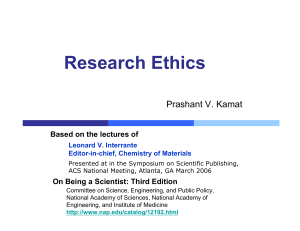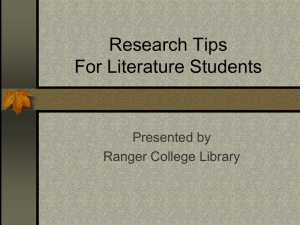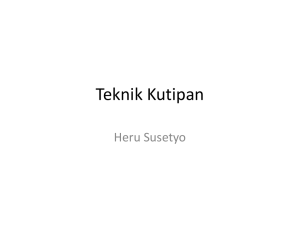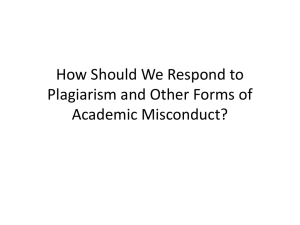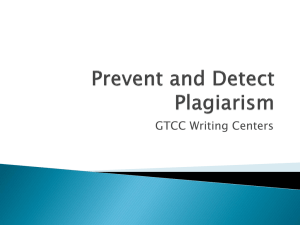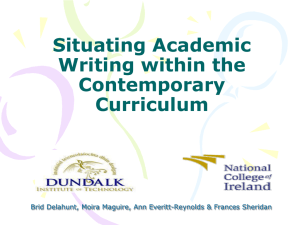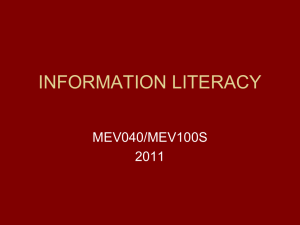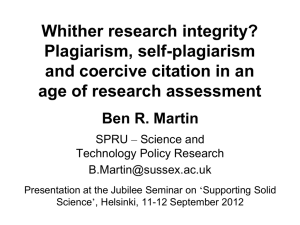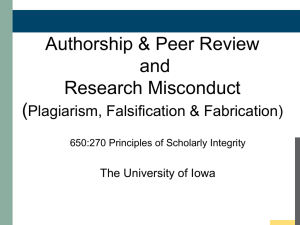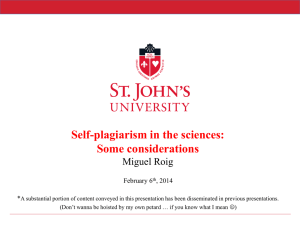PPTX - Avraham Samson`s Lab
advertisement
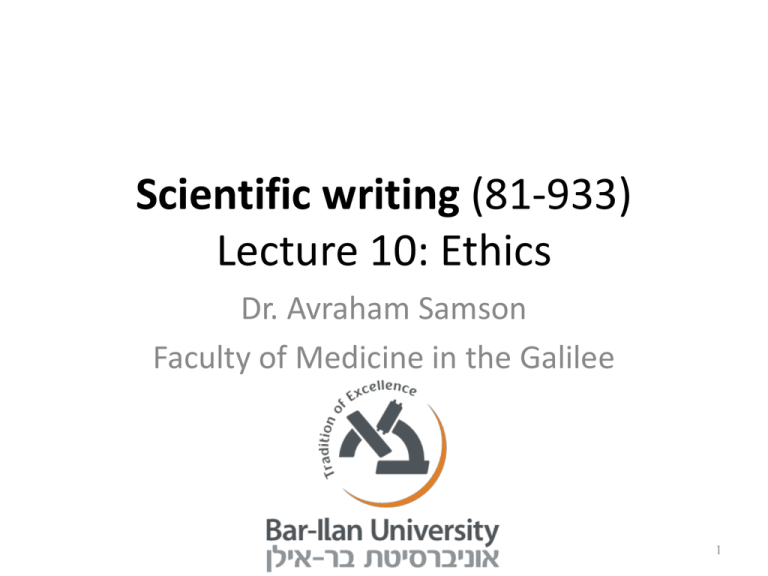
Scientific writing (81-933) Lecture 10: Ethics Dr. Avraham Samson Faculty of Medicine in the Galilee 1 Where do grad students learn ethics? 1. 2. 3. 4. 5. 6. 7. Mentor, advisor Fellow graduate students Family Friends not in graduate school Other faculty Religious beliefs Discussions in courses, labs, seminars 8. Professional organizations 9. Courses dealing with ethical issues Setting off on the road to the 2 responsible conduct of research Research Ethics Part I. Sharing Scientific Knowledge • Research publication • Authorship and collaborative Research • Scientific Misconduct • Examples of scientific misconduct in literature Part II Laboratory Practice and COI • Practices of Image and Data Manipulation • Data Ownership & Intellectual Property Guidelines • Conflict of Interest & Commitment • Government vs. Industry Sponsored Research • Sharing data in thesis • Who owns research data? 3 Scientific Knowledge • The object of research is to extend human knowledge beyond what is already known. • But an individual’s knowledge enters the domain of science only after it is presented to others in such a fashion that they can independently judge its validity (NAP, “On Being a Scientist” 1995) 4 Sharing Scientific Knowledge • “Science is a shared knowledge based on a common understanding of some aspect of the physical or social world” (NAP, “On Being a Scientist” 1995) Presentations • -Social conventions play an important role in establishing the reliability of scientific knowledge Publications in peer reviewed journals • -Research results are privileged until they are published Thesis 5 Why Publish? • “A paper is an organized description of hypotheses, data and conclusions, intended to instruct the reader. If your research does not generate papers, it might just as well not have been done” (G. Whitesides, Adv. Mater., 2004, 16, 1375) • “if it wasn’t published, it wasn’t done” -in E.H. Miller 1993 6 7 8 Authorship • The list of authors establishes accountability as well as credit. • Policies at most scientific journals state that a person should be listed as the author of a paper only if that person made a direct and substantial intellectual contribution to the design of the research, the interpretation of the data, or the drafting of the paper. • The acknowledgments section can be used to thank those who indirectly contributed to the work. • Including “honorary,” “guest,” or “gift” authors dilutes the credit due the people who actually did the work, inflates the credentials of the added authors, and makes the proper attribution of credit more difficult. Great manuscript! But the lab chief always gets listed as first author 9 Author Responsibilities • Preparation and Submission of Manuscripts: Follow General Rules: • Ensure work is new and original research • All Authors are aware of submission and agree with content and support submission • Agree that the manuscript can be examined by anonymous reviewers. • Provide copies of related work submitted or published elsewhere • Obtain copyright permission if figures/tables need to be reproduced Include proper affiliation 10 What is publishable… • Journals like to publish papers that are going to be widely read and useful to the readers • Papers that report “original and significant” findings that are likely to be of interest to a broad spectrum of its readers • Papers that are well organized and well written, with clear statements regarding how the findings relate to and advance the understanding/development of the subject • Papers that are concise and yet complete in their presentation of the findings 11 What is not acceptable… • Papers that are routine extensions of previous reports and that do not appreciably advance fundamental understanding or knowledge in the area . • Incremental / fragmentary reports of research results • Verbose, poorly organized, papers cluttered with unnecessary or poor quality illustrations • Violations of ethical guidelines, including plagiarism of any type or degree (of others or of oneself) and questionable research practices. 12 Research Misconduct Research misconduct means Fabrication, Falsification, or Plagiarism in proposing, performing, or reviewing research, or in reporting research results. (a) Fabrication is making up data or results and recording or reporting them. (b) Falsification is manipulating research materials, equipment, or processes, or changing or omitting data or results such that the research is not accurately represented in the research record. (c) Plagiarism is the appropriation of another person's ideas, processes, results, or words without giving appropriate credit. (d) Research misconduct does not include honest error or differences of opinion. http://ori.hhs.gov/definition-misconduct 13 Definitions: Plagiarism and Self-Plagiarism • Plagiarism: using the ideas or words of another person without giving appropriate credit (Nat. Acad. Press document) • Self-Plagiarism: The verbatim copying or reuse of one’s own research (IEEE Policy statement) Both types of plagiarism are considered to be unacceptable practice in scientific literature 14 ACS Publication Policy Plagiarism statement for Ethical Guidelines • • • B. 9. It is the responsibility of the author to ensure that the submitted manuscript is original and shall not contain plagiarized material. Plagiarism is passing off another person’s work as one’s own, i.e., reusing text, results, or creative expression without explicitly acknowledging or referencing the original author or publication. Authors should be aware this includes self-plagiarism, defined as the reuse of significant portions of the author’s own published work or works, without attribution to the original source. Examples of plagiarism include verbatim copying of published articles; verbatim copying of elements of published articles (e.g., figures, illustrations, tables); verbatim copying of elements of published articles with crediting, but not clearly differentiating original work from previously published work; and self-plagiarism. It is the responsibility of the author to obtain proper permission and to appropriately cite or quote the material not original to the author. In this context, “quote” is defined as reusing other works with proper acknowledgement. Appropriate citation applies whether the material was written by another author or the author him or herself. 15 A tale of two citations Mounir Errami & Harold Garner Nature 451, 397-399 (2008) • "It is the best of times, it is the worst of times". Scientific productivity, as measured by scholarly publication rates, is at an all-time high. However, high-profile cases of scientific misconduct remind us that not all those publications are to be trusted — but how many and which papers? • The most unethical practices involve substantial reproduction of another study (bringing no novelty to the scientific community) without proper acknowledgement. If such duplicates have different authors, then they may be guilty of plagiarism, whereas papers with overlapping authors may represent self-plagiarism. • Simultaneous submission of duplicate articles by the same authors to different journals also violates journal policies. 16 Mounir Errami & Harold Garner (2008) Nature 451, 397-399 China and Japan, have estimated duplication rates that are roughly twice that expected for the number of publications they contribute to Medline. Perhaps the complexity of translation between different scripts, differences in ethics training and cultural norms contribute to elevated duplication rates in these 17 two countries. Other Types of Ethical Violations • Duplicate publication/submission of research findings; failure to inform the editor of related papers that the author has under consideration or “in press” • Unrevealed conflicts of interest that could affect the interpretation of the findings (i.e. advisor to pharmaceutical company) • Misrepresentation of research findings -use of selective or fraudulent data to support a hypothesis or claim 18 Data Manipulation • Researchers who manipulate their data in ways that deceive others are violating both the basic values and widely accepted professional standards of science. • They mislead their colleagues and potentially impede progress in their field or research. • They undermine their own authority and trustworthiness as researchers. • Misleading data can also arise from poor experimental design or careless measurements as well as from improper manipulation. • When a mistake appears in a journal article or book, it should be corrected in a note, erratum (for a production error), or Additions/Corrections 19 Sooner or later ……. ethical violations get exposed Some recent examples 20 21 22 23 Recent cases http://ori.hhs.gov/case_summary 24 Citations -Read the study before you cite -Cite studies correctly and completely 25 The Plagiarism Hunter. When one graduate student went to the library, he found copycats — lots of them By PAULA WASLEY, Athens, Ohio In Ohio University's Library, Thomas A. Matrka takes just 15 minutes to hit pay dirt. Scattered before him on a table are 16 chemical-engineering master's theses on "multiphase flow.“ Identical diagrams in two theses from 2007 and 2008 strike him as suspicious. Turning a few more pages, he confirms what he suspected……….. Most of the plagiarism found at Ohio occurred in introductory chapters describing research methods and reviewing the previous literature in the field, for which there is little expectation of originality. And all but a few cases involved international students who, he says, whether through ignorance, laziness, or cultural misunderstanding, may have either not known correct citation practices or, struggling to write in a foreign language, been tempted to borrow another student's words. 26 How Journals Detect and Handle Problem Papers Detection • Information received from reviewers or other editors. • Literature search for related papers by the author. • Withdrawal of a paper from publication Action • Banning authors from publication in the journal for 3-5 years and informing the co-authors and editors of related journals of our action • For less serious cases, placing the author on a “watch list” for careful examination of their submissions prior to requesting reviews 27 A recent retraction …. Ethical Responsibilities for Authors in The Journal of Physical Chemistry I recently took the step of retracting from the scientific record a letter published in The Journal of Physical Chemistry C, as it is emblematic of a type of author misconduct that we as research professionals must seek to avoid if we are to uphold the integrity of the scientific literature. The letter in question was a publication by Fang et al., J. Phys. Chem. C 2007, 111, 1065-1070. After publication of the letter, it was brought to our attention that the paper by Fang et al., as submitted and subsequently published by the journal after peer review, included a number of figures that duplicated those contained within previously published papers by other authors ……... I judged such misconduct by the authors to constitute a serious instance of plagiarism. George Schatz Editor in Chief J. Phys. Chem. A/B/C 28 29 Double retraction • Fluorescence lifetime increase by introduction of F- ions in ytterbium-doped TeO2-based glasses (2005). Journal of Alloys and Compounds, 393:279-282 Guonian Wang, Shixun Dai, Junjie Zhang, Shiqing Xu and Zhonghong Jiang • Effect of F- ions on spectroscopic properties of Yb3+-doped zinc–tellurite glasses (2005) Journal of Physics and Chemistry of Solids, 66:1107-11 Guonian Wang, Junjie Zhang, Shixun Dai, Jianhu Yang and Zhonghong Jiang 30 31 32 33 34 35 36 37 38 39 40 • Or simply google a nice sentence… 41 42 43 44 45 46
